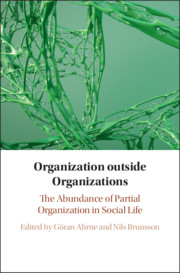Book contents
- Organization outside Organizations
- Organization outside Organizations
- Copyright page
- Contents
- Preface
- Contributors
- Introduction
- Part 1 Rules, Sanctions, Membership
- Part 2 Organization in and around Markets
- Part 3 Networks and Other Social Relationships
- Part 4 Social Movements and Collective Action
- 14 The Dilemma of Organization in Social Movement Initiatives
- 15 Alternating between Partial and Complete Organization: The Case of Anonymous
- 16 Collective Action through Social Media: Possibilities and Challenges of Partial Organizing
- Part 5 The Partial Organization of Formal Organizations
- Conclusion
- Index
- References
15 - Alternating between Partial and Complete Organization: The Case of Anonymous
from Part 4 - Social Movements and Collective Action
Published online by Cambridge University Press: 11 July 2019
- Organization outside Organizations
- Organization outside Organizations
- Copyright page
- Contents
- Preface
- Contributors
- Introduction
- Part 1 Rules, Sanctions, Membership
- Part 2 Organization in and around Markets
- Part 3 Networks and Other Social Relationships
- Part 4 Social Movements and Collective Action
- 14 The Dilemma of Organization in Social Movement Initiatives
- 15 Alternating between Partial and Complete Organization: The Case of Anonymous
- 16 Collective Action through Social Media: Possibilities and Challenges of Partial Organizing
- Part 5 The Partial Organization of Formal Organizations
- Conclusion
- Index
- References
Summary
This chapter is concerned with further advancing a process perspective on partial organization. More specifically, we address the question of how the different organizational elements of partial organization (i.e. membership, hierarchy, rules, monitoring, and sanctions) interrelate dynamically. Based on the emerging ‘communication as constitutive of organization’ (CCO) perspective in organization studies, we argue that social collectives can alternate between states of organizational ‘partialness’ and ‘completeness’ over time. The temporary and situational completion of partial organization can occur in and through communicative events that demonstrate and ‘celebrate’ a social collective’s ability to mobilize all five elements simultaneously. We illustrate our theoretical considerations by drawing on selected findings from an earlier empirical case study of the hacktivist collective Anonymous.
Keywords
- Type
- Chapter
- Information
- Organization outside OrganizationsThe Abundance of Partial Organization in Social Life, pp. 318 - 333Publisher: Cambridge University PressPrint publication year: 2019
References
- 2
- Cited by



